North Norway Publication Resources (Including D.Phil. Thesis)
This page contains publications that emphasize North Norway. Most major articles are accompanied by the abstract and a few key figures.
Neoproterozoic Glacial and Associated Facies in the Tanafjord-Varangerfjord Area, Finnmark, North Norway, GSA Field Guide 26 2012
Glaciogenic rocks of the Neoproterozoic Smalfjord and Mortensnes formations, Vestertana Group, E. Finnmark, Norway, Geological Society, London, Memoirs, 36, 2011
Upper Proterozoic passive margin deltaic complex, Finnmark N Norway GS 1989 Summary The upper Proterozoic Basnaering Formation in the 9000 m thick Barents Sea Group is a succession of deltaic siliciclastics, 2500-3500 m thick, with an exposed extent covering an area of 3000 km2. The Basnaering Formation is underlain by up to 3200 m of deep-marine submarine fan deposits, while above the deltaics there are up to 2500 m of shallow- and marginal-marine (intertidal and supratidal) carbonates and siliciclastics. The lower part of the Basnaering Formation records the changes from deep- to shallow-marine, slope and prodelta environments to delta-front, fluvial, marginal-marine interdistributary bay and related environments. The Basnaering Formation appears to record the northeastward progradation of a fluvially dominated wave-modified deltaic system. Tidal processes influenced the delta development, but the importance and magnitude of such tides remains uncertain. Gravity-controlled sediment instability was prevalent in the prodelta and delta-front environments CLOSE ALL Sedimentology of the Upper Proterozoic glacial record Vestertana Group Finnmark North Norway NGU 1984 ABSTRACT Upper Proterozoic sediments in Finnmark show direct and indirect evidence for glaciation in four stratigraphic units at the base of the Vestertana Group: 1) the Smalfjord Formation, the first glacial episode. 2) the Nyborg Formation which is interglacial. 3) the Mortensnes Tillite, the final glacial. and 4) the Lillevatn Member of the Stappogiedde Formation, which is postglacial. Each glacial formation rests on a glacially scoured, regional angular unconformity, and consists primarily of lodgement tillite with subordinate laminated mudstones, often with dropstones. The repeated vertical sequence erosively-based lodgement tillite overlain by laminated mudstone is interpreted as a submarine glacial retreat sequence. At least five such sequences are preserved in the Smalfjord Formation, and two in the Mortensnes Tillite. In addition. the lower part of the Smalfjord Formation fills two elongate paleovalleys that contain predominantly water-deposited facies. especially deposits of subaqueous sediment gravity flows and braided streams. Examination of deformation structures resulting from glacial shear indicates that ice sheets advanced not only from the south, but from the north as well. The interglacial and postglacial units both show evidence for local isostatic uplift and eustatic rise. Regressive basin fill sequences progress from relatively deep, quiet water. to shallow, agitated conditions. However, the style of the fills contrast in that the basinal facies of the interglacial Nyborg Formation is dominated by turbidite sandstones, while that of the postglacial Lillevatn Member is dominated by mudstones. Similarly, the shallow water deposits of the Nyborg Formation formed in a tide- and wave-dominated delta front, whereas those of the Lillevatn Member formed in coarse-grained alluvial channels. The sediment source for both units appears to have been primarily south of the basin. The structural and depositional center of this small epicontinental basin was situated southwest of Tanafjord. Enhanced glacial erosion of sediments adjacent to the Fennoscandian shield resulted in an asymmetric basin having a steep southern margin and a gentle northern margin. CLOSE ALL Late Precambrian tillites in Finnmark North Norway CUP 1981 INTRODUCTION Two glacial formations are recognized in Finnmark, both of them in the lower part of the Vestertana Group The ‘lower tillite’ is the Smalfjord Formation (Bjorlykke, Englund & Kirkhusmo, 1967) and includes the widely known ‘Bigganjargga Tillite’ (Edwards, 1975a). The ‘upper tillite’ is the Mortensnes Tillite Formation (Bjorlykke et al., 1967) . An image of this paper is shown below. CLOSE ALL Lithostratigraphy and sedimentation of Riphean Basnaering Formation Varanger Peninsula North Norway NGU 1980 Abstract The Riphean Basnaering Formation of the Barents Sea Group is a 2.5 – 3.5 km thick succession of sandstone, siltstone and claystone. It is subdivided into four formal members: the Naeringselva, Seglodden, Godkeila and Hestmann Members. The sedimentary structures and sequences suggest deposition in a deltaic environment. The Naeringselva Member consists of mudstones with slump and redeposition structures, interpreted as prodelta slopes, which pass upwards into stratified sandstones, interpreted as delta front. The upper three members comprise both delta-top fluvial sandstones and marginal, interdistributary, wave and tide-dominated sandstones and mudstones arranged in coarsening-upward sequences. Facies types and palaeocurrent trends suggest that the Basnaering delta was probably of lobate type and that the margins of the delta were subject to some marine reworking during general eastward progradation. Petrographic observations indicate a provenance of intermediate to basic plutonic rocks of their metamorphic counterparts, and possibly volcanics. CLOSE ALL Late Precambrian glacial loessites of north Norway and Svalbard JSP 1979 ABSTRACT Faintly stratified siltstones intercalated with late Precambrian tillites and glaciolacustrine and glaciomarine mudstones are interpreted to be indurated wind deposited silts, or “loessites.” In thin section, the siltstones are distinguished by their high silt and low clay content, comparatively good sorting, and abundance of angular particles. Samples show a preferred grain orientation both parallel and perpendicular to bedding, and together with previous observations on Quaternary loessites, support the use of grain orientation in determining paleowind direction and sediment source area. CLOSE ALL Late Precambrian subglacial tillites north Norway ICS 1975 INTRODUCTION It is generally agreed that subglacial tills (ground moraines) are massive internally, and may thus be convincingly identified only with difficulty. This paper describes inferred subglacial tillite units from the late Precambrian Smalfjord and Mortensnes Tillite Formations of East Finnmark, North Norway (Figs. 1 & 2). Reliable criteria for the recognition of such deposits are a prerequisite for the unraveling of the paleoclimatology and paleogeography of ancient continents and continental shelves. Also, such criteria ought to distinguish subglacial deposits from glacial marine sediments and from mudflows (subaqueous or subaerial). An image of this paper is shown below. CLOSE ALL Glacial retreat sedimentation in the Smalfjord Formation late Precambrian North Norway IAS 1975 ABSTRACT Tillites, conglomerates and sandstones occurring in the basal part of the Smalfjord Formation along the Varangerfjord, East Finnmark, North Norway are believed to have formed during the retreat of a glacier. At Kvalnes, on the south side of the fjord, the following sequence, up to 20 m thick, is found: (I) massive monomict tillite interpreted as a subglacial till, (2) massive polymict tillite with lenticular intercalations of stratified sandstone and tillite, interpreted as supraglacial/proglacial drift, (3) polymict conglomerate interstratified with laminated sandstones, interpreted as braided stream deposits. The last named interfingers laterally and is overlain by marine sandstones. At Bigganjargga, near the head of the fjord, a lens of tillite about 3 m thick rests on a striated pavement and is overlain by sandstones and shales. Part of the tillite, containing irregular patches of slightly winnowed tillite, is interpreted as a melt-out till, while a marginal part consisting of inclined tillite beds is interpreted as a series of flow till deposits. The lens is believed to be an oblique section through what was originally an ice-cored moraine ridge. During a subsequent transgression, the moraine was partially eroded, a lag conglomerate was formed, and overlying marine sediments were deposited. Bedded flow tills formed in a supraglacial/proglacial environment may be preserved where the extent of current reworking is very low (such as an isolated end moraine). Stratified conglomerate and sandstone, intimately intercalated with tillite, is to be expected at a glacier margin where glacial meltwater is locally and occasionally abundant, and glacier ablation permits downslope flowage of mobilized supraglacial fluid till. CLOSE ALL Stratigraphy of the Tanafjord Group and Vestertana Group, Stallogaissa Laksefjord District Finnmark NGS 1973 Abstract The area is underlain by the ‘Older Sandstone Series’ and the Vestertana Group of late Precambrian age. Formations within the Older Sandstone Series have been mapped for the first time in this area. They consist of a succession of quartzitic and ferruginous sandstones and shales, about 415 m thick. The Vestertana Group here comprises the Smalfjord Tillite and the Nyborg Formation. The regional unconformity beneath the Smalfjord Tillite has a major component of dip to the south, locally between 1′ and 4′. Facies in the Smalfjord Tillite include tillite, laminated siltstone, and waterlain ferruginous conglomerates and sandstones. Glacially transported blocks almost 1 km long, which occur at the base of the formation, complicate the interpretation of the stratigraphy and structure of the area. The formations in the Older Sandstone Series correlate with the Dakkovarre, Gamasfell, Vagge and Hanglecerro Formations in the upper part of the Older Sandstone Series of Tanafjord (Tanafjord Group). The similarities between the Tanafjord and Laksefjord Older Sandstone Series successions suggest that a major structural break does not occur between them. Rather the boundary between allochthonous and autochthonous Older Sandstone Series may be a gradual one. CLOSE ALL Late Precambrian and Cambro-Ordovician sedimentation in east Finnmark NGU 1971 Abstract The presence of two closely spaced tillite formations within the Precambrian and Cambro-Ordovician sediments of eastern Finnmark permits subdivision into pre-glacial and post-glacial regimes. On the northern side of Varangerfjord the preglacial “Older Sandstone Series” of Precambrian age consists of six lithological members, which collectively represent transgressive-regressive cycles. Within each cycle shallow marine siltstones are overlain by coarser sediments of intertidal, estuarine and fluvial origin. Two distinct sedimentary sources are suggested by palaeocurrent and petrographic evidence. Influx from a westerly direction tended to dominate over a volumetrically less significant source of immature detritus from the east or southeast. The “Older Sandstone Series” is overlain with slight angular unconformity by the glacially dominated sediments of the lower part of the Vestertana Group. The two tillite formations consist of both continental and marine glacial deposits, with marine influence increasing northward. The interglacial Nyborg Formation consists largely of turbidite sandstones, with a transgressive sequence at the base and a regressive sequence at the top. All of the sediments of the glacially dominated regime appear to have been derived from the south. Postglacial sediments of late Precambrian to Tremadocian age comprise all but the lowermost part of the Vestertana Group, together with the overlying Digermul Group. The succession is most fully developed in the Tanafjord area, and thins westward. The sediments reflect a predominance of shallow water deposition, with occasional deepening of the basin to permit the influx of turbidite sands which are interbedded with quiet water mudstones. The major source of the postglacial sediments appears to have been to the northeast, but the precise nature of this source remains problematical. CLOSE ALL Online version of 1972 Oxford University D. Phil. Thesis entitled GLACIAL, INTERGLACIAL, AND POSTGLACIAL SEDIMENTATION IN A LATE PRECAMBRIAN SHELF ENVIRONMENT, FINNMARK, NORTH NORWAY, including both the scanned text and figures in PDF format (Volume I), as well as the complete set of scanned photographic plates (Volume II).Siedlecka, A, Pickering, K. T. and Edwards, 1989: Upper Proterozoic passive margin deltaic complex, Finnmark N Norway. In Whateley, M. K. G. & Pickering, K. T. (eds.), Deltas: Sites and Traps for Fossil Fuels, Geological Society Special Publication No, 41, 205-219.
Edwards 1984: Sedimentology of the Upper Proterozoic glacial record, Vestertana Group, Finnmark, North Norway. Bull. Geol. Surv. Norway 394, 1-76.
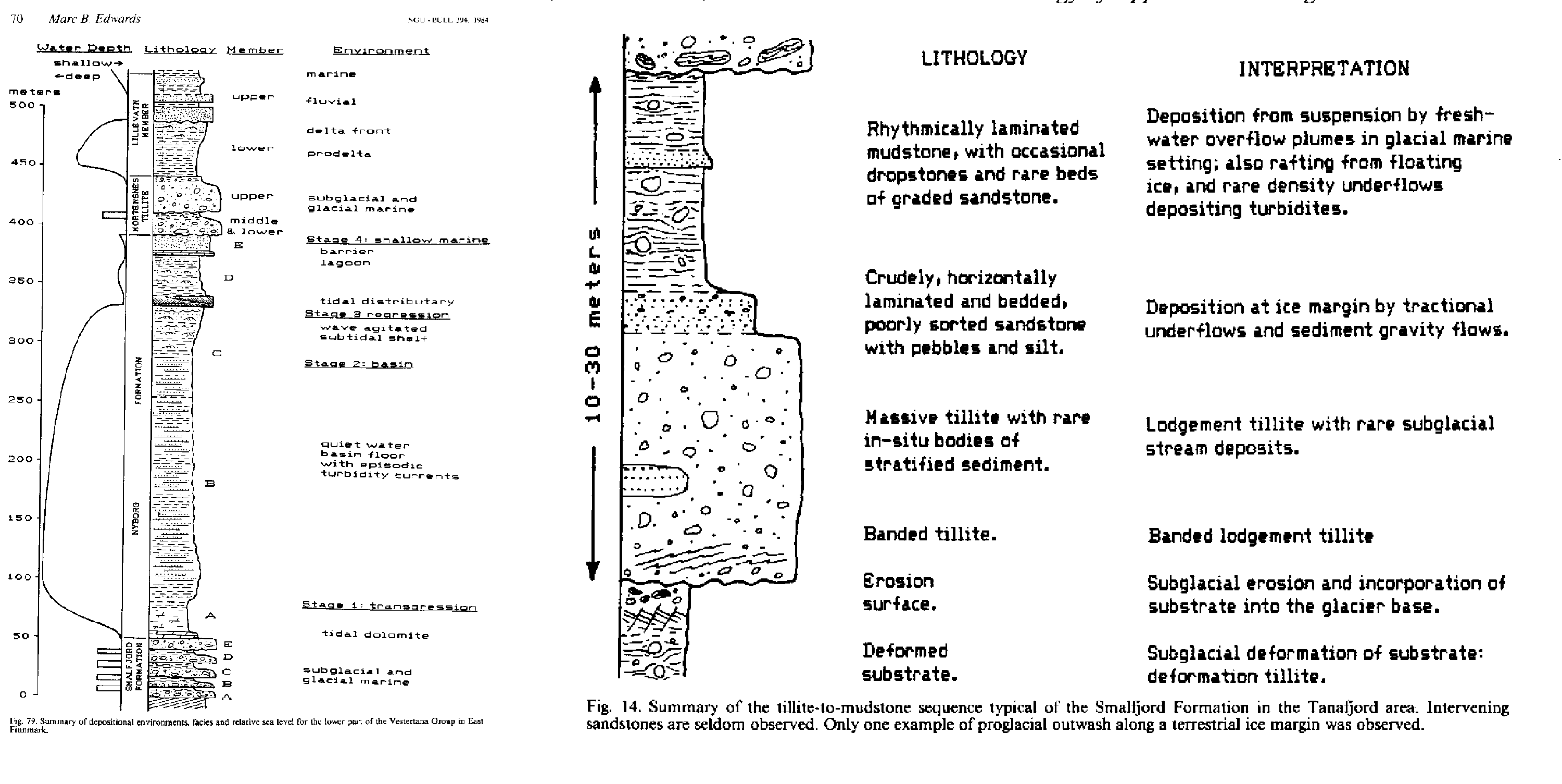
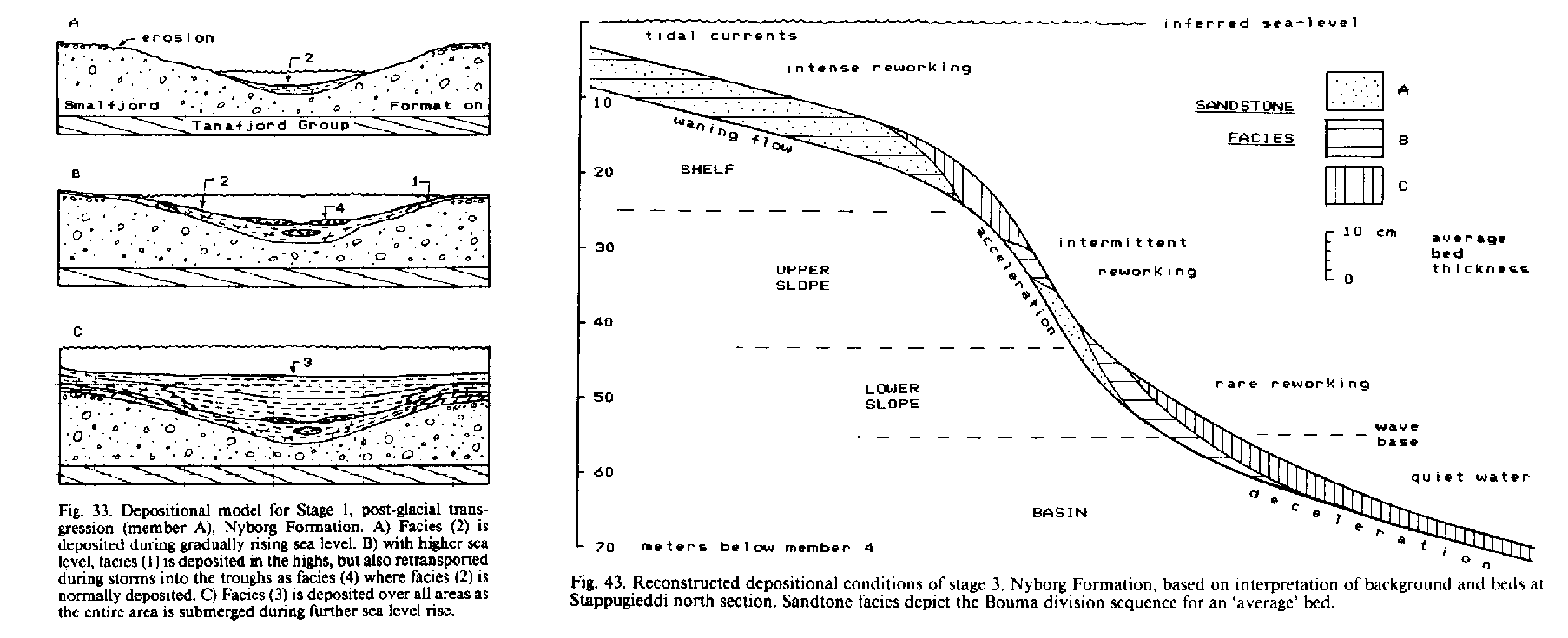

Edwards and Foyn, S. 1981: Late Precambrian tillites in Finnmark, North Norway. In: Earth’s pre-Pleistocene Glacial Record (Eds. M.J. Hambrey & W.B. Harland), Cambridge Univ. Press, 606-610.
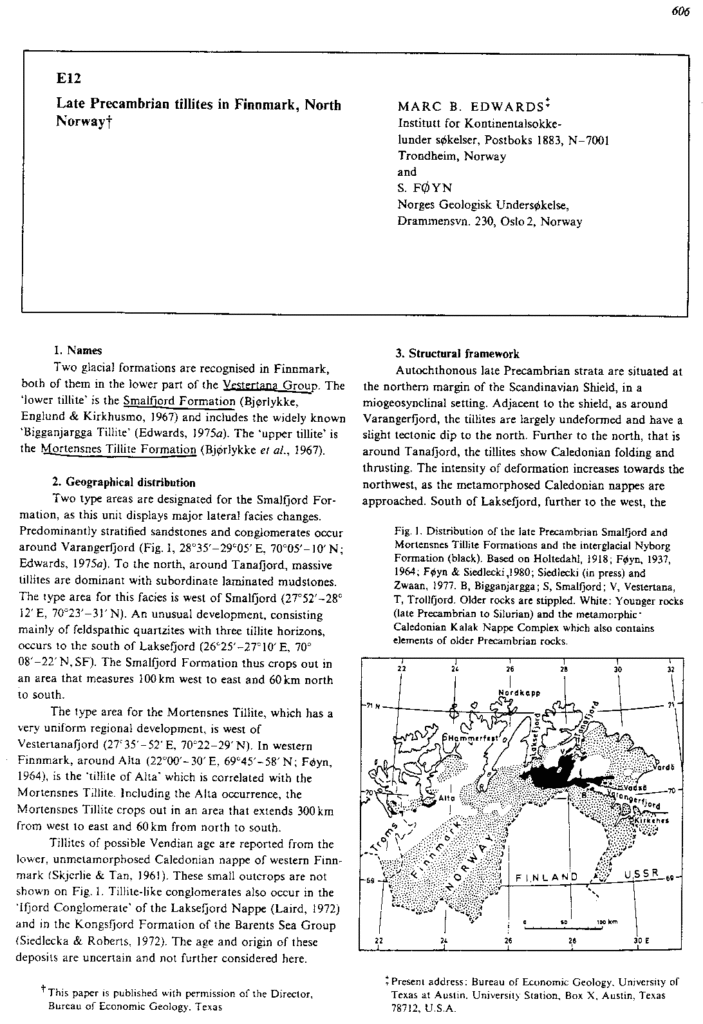
Siedlecka, A and Edwards, 1980: Lithostratigraphy and sedimentation of the Riphean Basnaering Formation, Varanger Peninsula, North Norway. Norges geol. Unders. 355, 27-47.
Edwards 1979: Late Precambrian glacial loessites of north Norway and Svalbard. J. Sedim. Petrol. 49, 85-92.
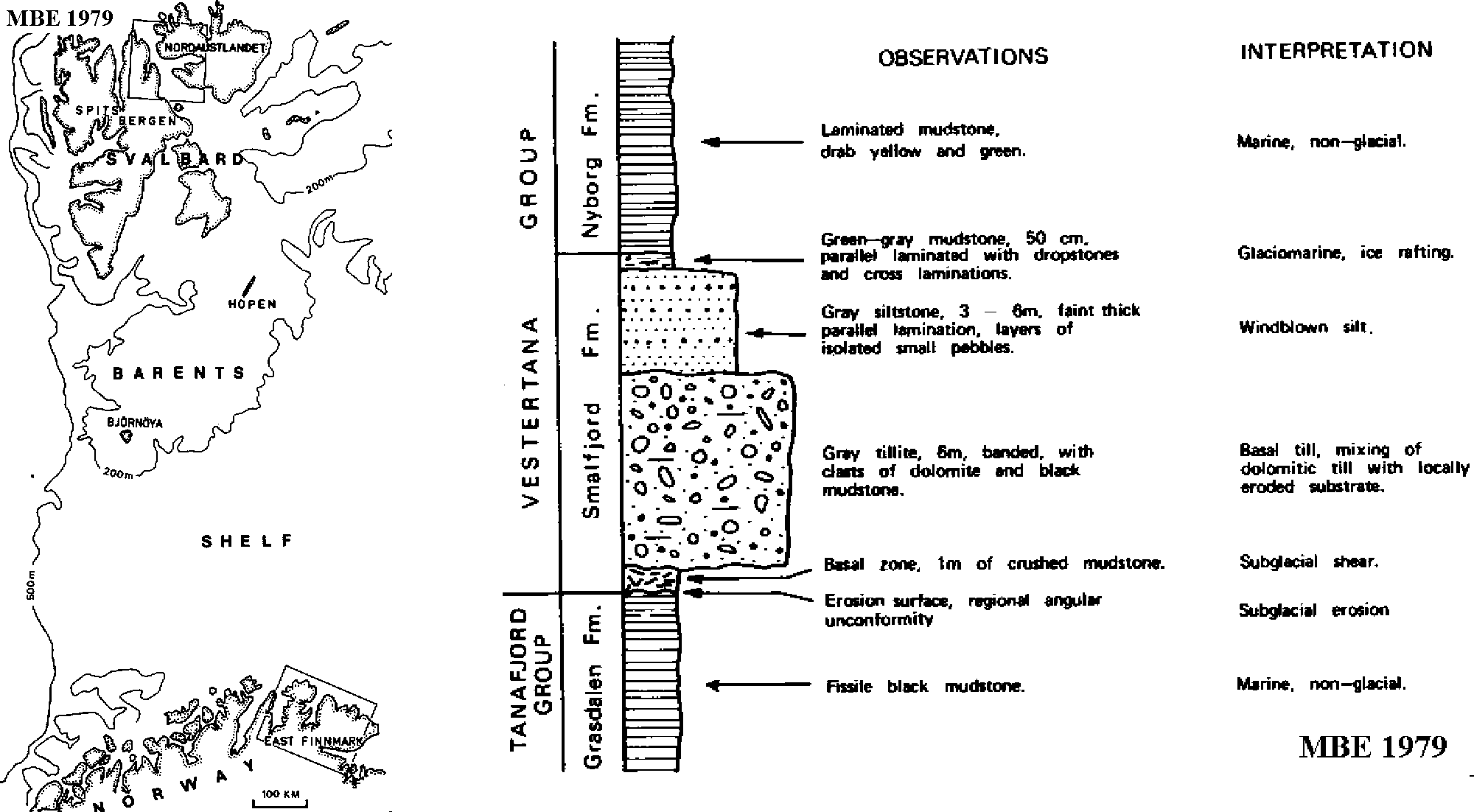
Edwards 1975: Late Precambrian subglacial tillites, north Norway. Proc. 9th Intl. Congr. Sedimentology, Nice, 1, 61-66.

Edwards 1975: Glacial retreat sedimentation in the Smalfjord Formation, late Precambrian, North Norway. Sedimentology, 22, 75-94.
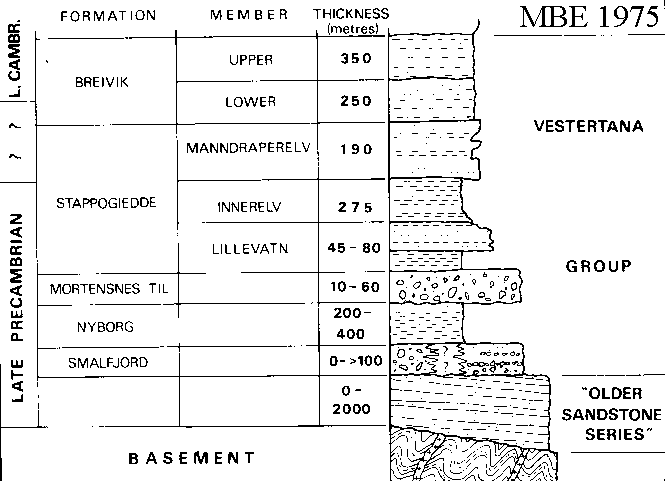
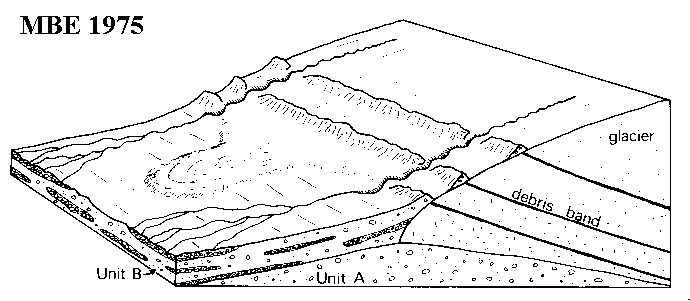
Edwards, Baylis, P., Gibling, M., Goffe, W., Potter, M. and Suthren, R.J., 1973: Stratigraphy of the “older sandstone series” (Tanafjord Group) and Vestertana Group north of Stallogaissa, Laksefjord District, Finnmark. Norges geol. Unders. 294, 25-41.
Banks, N.L., Edwards, Geddes, W.P., Hobday, D.K. and Reading, H.G. 1971: Late Precambrian and Cambro-Ordovician sedimentation in east Finnmark. In: The Caledonian Geology of northern Norway (Eds. D. Roberts & M. Gustavson), Norges geol. Unders. 269, 197-236